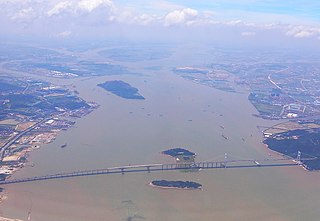
Yue is a branch of the Sinitic languages primarily spoken in Southern China, particularly in the provinces of Guangdong and Guangxi.

Guilin, formerly romanized as Kweilin, is a prefecture-level city in the northeast of China's Guangxi Zhuang Autonomous Region. It is situated on the west bank of the Li River and borders Hunan to the north. Its name means "forest of sweet osmanthus", owing to the large number of fragrant sweet osmanthus trees located in the region. The city has long been renowned for its scenery of karst topography.

The Pearl River is an extensive river system in southern China. "Pearl River" is often also used as a catch-all for the watersheds of the Pearl tributaries within Guangdong, specifically the Xi ('west'), Bei ('north'), and Dong ('east'). These rivers all ultimately flow into the South China Sea through the Pearl River Delta. Measured from the farthest reaches of the Xi River, the Pearl–Xi–Xun–Qian–Hongshui–Nanpan 2,400 km (1,500 mi) Pearl River system constitutes China's third-longest, after the Yangtze River and the Yellow River, and its second largest by volume, after the Yangtze. The 453,700 km2 (175,200 sq mi) Pearl River Basin drains the majority of Guangdong and Guangxi provinces, as well as parts of Yunnan, Guizhou, Hunan and Jiangxi; it also drains the northernmost parts of Vietnam's Northeast Cao Bằng and Lạng Sơn provinces. The Pearl River is famed as the river that flows through Guangzhou.

Zhaoqing, alternately romanized as Shiuhing, is a prefecture-level city in Guangdong Province, China. As of the 2020 census, its population was 4,113,594, with 1,553,109 living in the built-up area made of Duanzhou, Dinghu and Gaoyao. The prefectural seat—except the Seven Star Crags—is fairly flat, but thickly forested mountains lie just outside its limits. Numerous rice paddies and aquaculture ponds are found on the outskirts of the city. Sihui and the southern districts of the prefecture are considered part of the Pearl River Delta.

Wuzhou, formerly Ngchow, is a prefecture-level city in the east of Guangxi Zhuang Autonomous Region, People's Republic of China.

The Hongshui River is a major river in the Guangxi Zhuang Autonomous Region in Southern China. It is one of the main rivers in the basin of the Xi River, which in its turn is one of the main tributaries of the Pearl River. Because it flows through the red rock series area, the river is reddish brown, hence the name Hongshui River.

Baise, or Bose, is the westernmost prefecture-level city of Guangxi, China bordering Vietnam as well as the provinces of Guizhou and Yunnan. The city has a population of 4.3 million, of which 1.4 million live in the urban area.

Hezhou (贺州) is a prefecture-level city in the northeast of the Guangxi Zhuang Autonomous Region, People's Republic of China.

Guigang is a prefecture-level city in eastern Guangxi in the People's Republic of China. Prior to 1988, it was known as Gui County or Guixian.

The Gui River is a river in the Guangxi Zhuang Autonomous Region of China, and a tributary of the Xi Jiang. It is formed in Pingle by the confluence of the Li River and Lipu River and flows southeast, merging with the Xun Jiang to form the Xi at Wuzhou.
Teng County or Tengxian is a county of eastern Guangxi, China. It is under the administration of the prefecture-level city of Wuzhou. As of 2021, it had a population of 1,125,264 residing in an area of 3,945.62 km2 (1,523.41 sq mi). The county is divided into a northern and southern part by the Xun River.
Tianyang District is a district in western Guangxi, China. It is under the administration of the prefecture-level city of Baise.

Fusui County is a county in the southwest of Guangxi, China. It is the easternmost county-level division of the prefecture-level city of Chongzuo.
Qinzhou Power Station, also spelled Qinzhou Power Plant, is a Chinese thermal power plant located at Qinzhou Bay (钦州湾). It is a national key power construction project in China.

Shuikou is a town in Longzhou County, Chongzuo, Guangxi, China. It is a border town of Tà Lùng in Vietnam. Due to its location on the border crossing to Vietnam and its educational and medical infrastructure, Shuikou is of regional importance.
Li Xinyuan is a former Chinese politician who served as mayor and party secretary of Guigang in Guangxi. He was investigated by China's top anti-graft agency in March 2021. He was a representative of the 19th National Congress of the Chinese Communist Party.

Zhenwu Pavilion is a Chinese pavilion located in Rong County, Guangxi. Alongside Yuejiang Tower, Xie Tiao Tower and Zhenhai Tower, it is one of the Four Great Towers of Jiangnan.
Liu Jun is a former Chinese politician who spent most of his career in southwest China's Guangxi Zhuang Autonomous Region. He was investigated by China's top anti-graft agency in February 2018. Previously he served as vice chairman of the Guangxi Regional Committee of the Chinese People's Political Consultative Conference and before that, chairman of the Standing Committee of Guilin Municipal People's Congress and party secretary of Guilin.
Huang Fangfang is a former Chinese politician who served as director of the Development and Reform Commission of Guangxi Zhuang Autonomous Region between 2011 and 2018. He was investigated by China's top anti-graft agency in November 2022.














